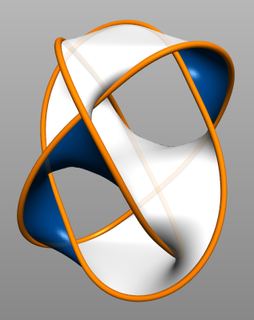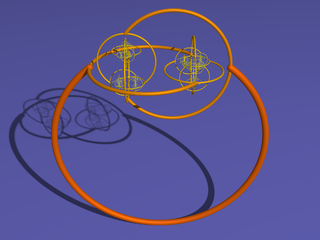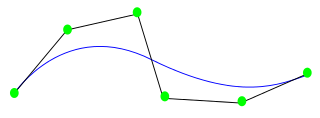Related Research Articles
In algebraic topology, a homology sphere is an n-manifold X having the homology groups of an n-sphere, for some integer . That is,

In mathematics, geometric topology is the study of manifolds and maps between them, particularly embeddings of one manifold into another.

In mathematics, low-dimensional topology is the branch of topology that studies manifolds, or more generally topological spaces, of four or fewer dimensions. Representative topics are the structure theory of 3-manifolds and 4-manifolds, knot theory, and braid groups. This can be regarded as a part of geometric topology. It may also be used to refer to the study of topological spaces of dimension 1, though this is more typically considered part of continuum theory.

The Alexander horned sphere is a pathological object in topology discovered by J. W. Alexander (1924).

In mathematics, a 3-manifold is a space that locally looks like Euclidean 3-dimensional space. A 3-manifold can be thought of as a possible shape of the universe. Just as a sphere looks like a plane to a small enough observer, all 3-manifolds look like our universe does to a small enough observer. This is made more precise in the definition below.
Algorithmic topology, or computational topology, is a subfield of topology with an overlap with areas of computer science, in particular, computational geometry and computational complexity theory.
In mathematics, a 4-manifold is a 4-dimensional topological manifold. A smooth 4-manifold is a 4-manifold with a smooth structure. In dimension four, in marked contrast with lower dimensions, topological and smooth manifolds are quite different. There exist some topological 4-manifolds which admit no smooth structure, and even if there exists a smooth structure, it need not be unique.

In mathematics, topology generalizes the notion of triangulation in a natural way as follows:
In mathematics, a manifold is a topological space that locally resembles Euclidean space near each point. More precisely, an n-dimensional manifold, or n-manifold for short, is a topological space with the property that each point has a neighborhood that is homeomorphic to the Euclidean space of dimension n.
In mathematics, a piecewise linear (PL) manifold is a topological manifold together with a piecewise linear structure on it. Such a structure can be defined by means of an atlas, such that one can pass from chart to chart in it by piecewise linear functions. This is slightly stronger than the topological notion of a triangulation.
The Hauptvermutung of geometric topology is the question of whether any two triangulations of a triangulable space have subdivisions that are combinatorially equivalent, i.e. the subdivided triangulations are built up in the same combinatorial pattern.
In mathematics, more specifically in geometric topology, the Kirby–Siebenmann class is an obstruction for topological manifolds to allow a PL-structure.

Robion Cromwell Kirby is a Professor of Mathematics at the University of California, Berkeley who specializes in low-dimensional topology. Together with Laurent C. Siebenmann he invented the Kirby–Siebenmann invariant for classifying the piecewise linear structures on a topological manifold. He also proved the fundamental result on the Kirby calculus, a method for describing 3-manifolds and smooth 4-manifolds by surgery on framed links. Along with his significant mathematical contributions, he is an influential figure in the field, with over 50 doctoral students and his famous problem list.
In 4-dimensional topology, a branch of mathematics, Rokhlin's theorem states that if a smooth, closed 4-manifold M has a spin structure, then the signature of its intersection form, a quadratic form on the second cohomology group , is divisible by 16. The theorem is named for Vladimir Rokhlin, who proved it in 1952.
In the mathematical area of topology, the generalized Poincaré conjecture is a statement that a manifold which is a homotopy sphere is a sphere. More precisely, one fixes a category of manifolds: topological (Top), piecewise linear (PL), or differentiable (Diff). Then the statement is

In geometric topology, PDIFF, for piecewise differentiable, is the category of piecewise-smooth manifolds and piecewise-smooth maps between them. It properly contains DIFF and PL, and the reason it is defined is to allow one to relate these two categories. Further, piecewise functions such as splines and polygonal chains are common in mathematics, and PDIFF provides a category for discussing them.

John Robert Stallings Jr. was a mathematician known for his seminal contributions to geometric group theory and 3-manifold topology. Stallings was a Professor Emeritus in the Department of Mathematics at the University of California at Berkeley where he had been a faculty member since 1967. He published over 50 papers, predominantly in the areas of geometric group theory and the topology of 3-manifolds. Stallings' most important contributions include a proof, in a 1960 paper, of the Poincaré Conjecture in dimensions greater than six and a proof, in a 1971 paper, of the Stallings theorem about ends of groups.
James W. Cannon is an American mathematician working in the areas of low-dimensional topology and geometric group theory. He was an Orson Pratt Professor of Mathematics at Brigham Young University.
This is a timeline of manifolds, one of the major geometric concepts of mathematics. For further background see history of manifolds and varieties.
In geometric topology, a branch of mathematics, Moise's theorem, proved by Edwin E. Moise in Moise (1952), states that any topological 3-manifold has an essentially unique piecewise-linear structure and smooth structure.
References
- ↑ Robert D. Edwards, "Suspensions of homology spheres" (2006) ArXiv (reprint of private, unpublished manuscripts from the 1970's)
- ↑ Robert D. Edwards, "The topology of manifolds and cell-like maps", Proceedings of the International Congress of Mathematicians, Helsinki, 1978 ed. O. Lehto, Acad. Sci. Fenn (1980) pp 111-127.
- ↑ James W. Cannon, "Σ2 H3 = S5 / G", Rocky Mountain J. Math. (1978) 8, pp. 527-532.
- Cannon, James W. (1979), "Shrinking cell-like decompositions of manifolds. Codimension three", Annals of Mathematics , Second Series, 110 (1): 83–112, doi:10.2307/1971245, ISSN 0003-486X, MR 0541330
- Latour, François (1979), "Double suspension d'une sphère d'homologie [d'après R. Edwards]", Séminaire Bourbaki vol. 1977/78 Exposés 507–524, Lecture Notes in Math. (in French), 710, Berlin, New York: Springer-Verlag, pp. 169–186, doi:10.1007/BFb0069978, ISBN 978-3-540-09243-8, MR 0554220
- Steve Ferry, Geometric Topology Notes (See Chapter 26, page 166)